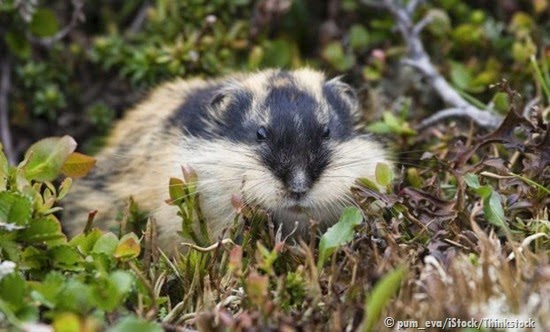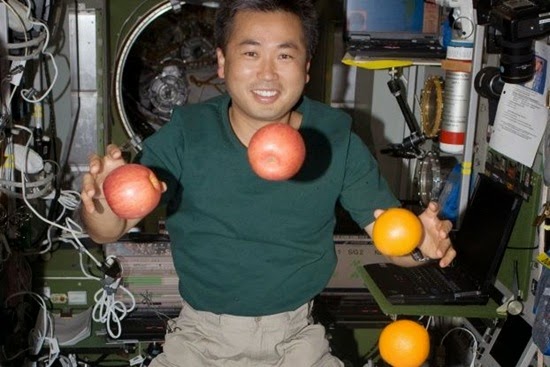
When spouting off hazy facts, there's no better retort to a sceptical audience than calmly explaining that it's not just true - it's science.
Science, after all, can forgive a host of sins. Sometimes it even works. Your taste buds really do only last a week or two before being shoved aside for new ones [source: Chudler]. Rice has more genes than a human being [source: Reporter]. Lemmings are pathologically suicidal. It's science, folks.
But hold your rodents. Because some of the scientific facts we have heard, internalized and spread are straight up bogus. To start with, our little lemming friends [top image] got a rap for clinical depression based on a "documentary" by Disney that completely fabricated the mass suicide of lemmings by cliff-plunge idea [source: Woodford]. In fact, lemmings, like all sorts of wild animals, go through population explosions, followed by migration and dispersal. The footage Disney provided of lemmings jumping to their deaths? Totally staged.
Of course, not all our false science facts were created on a film set. Read on for some extremely common misconceptions that those who study biology, medicine, physics and meteorology just can't seem to shake.
10. Flu shots give you a mild flu
Yeah, your arm might be sore after you get your flu shot, but it's certainly not going to give you the flu.
There's nothing that raises the hackles of medical professionals like trying to explain to them that you don't want the flu shot because you don't want the flu.
Try it sometime. Tell your friendly public health worker that you won't get the shot, thank you very much, because all your co-workers "got the flu" after their vaccine.
Then watch them turn a shade of purple as they explain through gritted teeth that while your co-workers might've felt a bit off after their shot - or might've become infected with the flu before the vaccine took effect - they did not get the flu from the shot.
You can experience some really mild symptoms from the vaccine that are a distant shade of actual influenza. (Think muscle soreness or mild fever, and chalk them up to the body creating antibodies in response to the vaccine.) You also can still get the flu if you're infected within a two-week period of the vaccination, or if you simply get another infection besides the seasonal influenza [source: CDC]. But you are unequivocally not going to get the flu from the flu shot.
9. The Big Bang theory explains where the universe came from
Artist rendering of what the big bang might have looked like.
Have you ever heard (or said yourself) something like this: Out of nothing, there was an astoundingly large explosion and - ta-da! - the universe was created.
Unfortunately, that's not actually what the big bang describes. Rather, it tries to explain the expansion of the universe. It doesn't say how the universe came to be but what the universe did to become gigantic.
Although most of us envisioned the big bang as an explosion at least worthy of a Jerry Bruckheimer movie, we were wrong about that as well. Sure, the not-even-microscopic centre of everything inflated to an easily discernible size in less than a trillionth of a trillionth of a trillionth of a second - but no fireballs or clouds of thick smoke were engulfing muscled heroes who might've been around to dive out of the way [source: Khan].
8. Milk helps you grow up tall and strong
Is drinking milk going to make her taller? Not necessarily.
We've heard it from moms, dads, teachers, doctors, and - perhaps most tellingly - the dairy industry.
As a 5-foot (1.5-meter)-tall weakling who was forced to drink milk every day of her adolescence, it does strike me that this science "fact" is either A) not fool proof or B) an indication that without help from calcium, I might've topped out at 4 feet 2 inches (1.3 meters) with broken fingers from moderately strenuous piano practice.
Let's ignore anecdote and stick with evidence-based study. Some scientists and nutritionists have argued that the U.S. dairy guidelines are overwhelming: three cups (0.7 litres) of milk or equivalent dairy (like yogurt or cheese) a day for anyone older than 8 [source: Kelly]. Researchers at Harvard and Cornell have both noted that increased milk intake didn't correlate to higher bone strength. However, be aware that plenty of conflicting studies do indicate calcium increases bone health [source: Kelly].
Some researchers even argue that Americans, with their high dairy diet, are actually victims of weaker bone structure due to the blood and tissues pulling calcium from the bones to counteract the high acidity in the animal protein of dairy. Important to note? Nobody claims drinking milk will make you taller.
7. The Coriolis effect controls flushing toilets
Now is that bowl in the Northern or Southern Hemisphere?
As Jane Austen would say, it's a truth universally acknowledged that the Coriolis effect determines the way water moves in a flushed toilet.
Perhaps she wouldn't be discussing toilets, what with Georgian era manners and all that. Point taken. But if Austen were alive today, she'd probably be like the rest of us and assume the Coriolis effect - which says Earth's rotation affects how we see the movement of certain objects - influences the direction of our toilet water. The idea is that planetary rotation causes the water to spin clockwise in the Northern Hemisphere, counter-clockwise in the Southern.
Of course, you're starting to get the idea - this is another inaccurate science fact. In reality, the Coriolis effect isn't going to make any difference when the force of the flush is so strong. Even the shape of the bowl needs to be accounted for [source: Scientific American]. Coriolis can noticeably affect giant things in Earth's atmosphere, such as the Gulf Stream, but not smaller phenomena like curveballs or flushing toilets [source: Boyd].
6. There's no gravity in space
If you're like me, one of the scariest things about space is the fact that gravity doesn't exist there. If you fall out of the space shuttle - admittedly, a strange thing to happen, but just go with it since you can't contradict my personal phobia - you don't hit anything. You just float, forever, dead or alive, until you bump into an alien planet filled with mean birds. (Another phobia. Don't judge.)
But good news for those of us who fear our clumsiness would cause a literal trip into outer space: Gravity does exist in space! We're not saying that previous astronauts were faking weightlessness. Rather they were experiencing microgravity, or gravity that's quite weak in comparison with what we experience on Earth. It exists in spacecraft orbiting Earth because the spacecraft are literally kept in orbit by the Earth's gravity, which still exerts a power hundreds of miles from the planet [source: Glenn Research Centre].
Just as you previously thought, if an astronaut were to slip on a banana peel in the space station, she definitely would not fall down. Instead, we're saying that microgravity is making her fall at the same rate that everything else is falling, around each other. Hence the floating effect.
5. Lightning never strikes the same spot twice
We've been a bit misinformed about those bolts.
We all know that the absolute safest thing you can do in a storm is predict where lighting will hit and then immediately run as fast as you can to every other spot in the world and wait out the storm patiently. Invincible. Forever. Because when lightning strikes, each flash only strikes in one place.
Doesn't sound right, does it?
The thought that lightning doesn't strike twice is lovely sentiment when Grandpa is doling out folksy wisdom, but please don't rely on Gramps in a thunderstorm. In 2003, scientists found that lightning doesn't just strike one place when it hits the earth. On average, it hits 1.45 places at a strike [source: Goddard Space Flight Centre].
The scientists extrapolated that your chances of being hit by lightning was actually 45 percent higher than the number of flashes, because it does hit in 0.45 more places.
And oh yeah, lightning definitely strikes the same place twice. Sometimes even thrice. Just ask the Empire State Building.
4. Summer's hotter because you're closer to the sun
The sun prepares to set on June 28, 2014. The photo was taken at California's Seal Beach, which
experiences summer from June through September, thanks to the angle of the sun's rays hitting Earth.
Ah, summer! That magical time of the year when your hemisphere reaches as close to the sun as it can go, yearning for a burning hug that's only slightly cooled by aloe vera. After a day at the beach with nothing more than one application of SPF 15, you might be cursing our planet for tipping you so close.
Because hey, we all know that's what summer is - we're leaning closer to the sun! In the winter we're leaning away from the sun. Voilá! SCIENCE.
Totally inaccurate and misunderstood science.
We are right in one respect: The sun is super hot. Yet at 93 million miles (150 million kilometres) away, it's not so hot that a little lean this way or that matters to us beach or ski bums. It's not the proximity of your hemisphere to the sun that makes summer warm and winter cold; it's the angle that the sun's rays hit us. In the summer, the sun's rays hit right on us. In the winter, the sun's rays are slanted down, away from us [source: GEMS].
3. People's nails grow after they're dead
Think you're going to boast fingernails like these when you die? Think again.
A persistent myth states that all sorts of biological functions occur for days or even months after death. There's some truth to that. Think about the fact that for an organ transplant to occur, the organ can't immediately and utterly fail. Instead, the cells can thrive for hours after the more profound expiration of life.
Glucose ceases to be produced upon death, however, which does affect some new cell growth. That means that fingernails and hair - which rely on glucose for production - stop growing pretty much immediately [source: Hammond].
But do know this: Because the skin retracts when dehydrated, it can absolutely appear that the fingernails are longer on a dead person or that more visible stubble is present, looking, for all intents and purposes, that hair and nails have been growing all along.
2. Sugar makes kids hyperactive
Are they just burning off energy, or are they riding a sugar high?
A lot of us can bring to mind the specific horror of watching a swarm of 8-year-olds devour cake, ice cream and candy at a birthday party. It's not just the fear of rotten teeth or upset stomachs; it's the much deeper - much harder to treat - concern of the dreaded Sugar Rush. The one that causes manic bursts of activity. The one that leads to tantrum-filled crashes.
While it might feel inevitable, the truth is that there's no real link between sugar and hyperactivity in youngsters [source: Wolraich]. In fact, one 1994 study showed that mothers who thought their children drank a sugary drink were convinced the kids were hyperactive, despite receiving a placebo. The mothers who thought the kids drank sugar were observed, and it was noted that they hovered and scolded their children more than mothers who were told their children received a placebo [source: Hoover].
1. Just about everything you know about colds
Downing vitamin C won't stop you from getting a cold.
When it comes to the common cold, fake "facts" are in overdrive - thanks, in part, to how common it is. Since a cold is so easy to catch - and so difficult to relieve - everyone and their cousin seems to have a theory about how to get (or avoid) the sniffles. So let's jump in and debunk all the "facts" we know about colds.
First off, stop taking large doses of vitamin C. While it's super for you if you're a sea captain in the 18th century at risk of scurvy, there has been no conclusive test proving it's helping you prevent a cold [source: UAMS]. At best, it might help dry up some nasal secretions, after the fact, but certainly isn't worth the exorbitant price of products like Airborne [source: Fresh Air].
Next, being out in the cold isn't going to give you a cold (or influenza, for that matter). In fact, being indoors is the problem. In the winter, we're more likely to shutter ourselves inside and transmit our colds and flus much easier to those around us [source: UAMS]. And while my mother might've tried to convince me that stepping outside with sopping wet hair would lead to the usual sore-throat-runny-nose business, that was probably no more than a bluff to get me to look presentable in public. Having a wet head will not give anyone a cold.
Author's Note: I know it's not scientific, but the poor lemmings. Why would Disney want to create a narrative where innocent rodents were painted as pathologically morbid? Read more about the controversy here.
Related Articles:
Article Sources:
1. Ask the Experts. "Can somebody finally settle the question." Scientific American. Jan. 28, 2001. (June 12, 2014)
2. Boyd, Robynne. "Fact or fiction?" Scientific American. June 28, 2007. (June 12, 2014)
3. Centres for Disease Control and Prevention (CDC). "Seasonal Flu Shot." United States Government. Sept. 26, 2013. (June 12, 2014)
4. Chudler, Eric. "Neuroscience for Kids: That's Tasty." University of Washington. (June 12, 2014)
5. Ferris, Robert and Welsh, Jennifer. "35 science 'facts' that are totally wrong." Business Insider. July 2, 2013. (June 12, 2014)
6. Fresh Air. "'Ah-choo!' takes on mysteries of the common cold." NPR. Sept. 13, 2010. (June 12, 2014)
7. Glenn Research Centre. "What is microgravity?" NASA. (June 12, 2014)
8. Great Explorations in Math and Science (GEMS). "Does earth-sun distance cause seasons?" Lawrence Hall of Science, University of California, Berkeley. 2008. (June 12, 2014)
9. Hammond, Claudia. "Do your hair and fingernails grow after death?" BBC. May 28, 2013. (June 12, 2014)
10. Hammond, Claudia. "Does sugar make children hyperactive?" BBC. July 23, 2014. (June 12, 2014)
11. Helmuth, Laura. "Top ten myths about the brain." Smithsonian Magazine. May 19, 2011. (June 12, 2014)
12. Hoover, DW et al. "Effects of sugar ingestion expectancies on mother-child interactions." Journal of Abnormal
Child Psychology. August 1994. (June 12, 2014)
13. Kelly, Alice Lesch. "The dairy debate." Los Angeles Times. March 7, 2005. (June 12, 2014)
14. Khan, Amina. "Evidence of young universe's growth spurt is discovered." Los Angeles Times. March 17, 2014. (June 12, 2014)
15. Kluger, Jeffrey. "10 science myths that won't go away." TIME. March 7, 2014. (June 12, 2014)
16. Reporter. "Humans have fewer genes than rice." The Newspaper of Imperial College London. July 2002. (June 12, 2014)
17. University of Arkansas Medical Sciences. "Medical Myths." 2014. (June 12, 2014)
18. Wolraich, Mark et al. "The effect of sugar on behaviour or cognition in children." The Journal of the American Medical Association. November 1995. (June 12, 2014)
19. Woodford, Riley. "Lemming suicide myth." Alaska Department of Fish and Game. Sept. 2003. (June 12, 2014)
Top image: Norway lemming (lemmus lemmus). Credit: pum_eva/iStock/Thinkstock.










No comments:
Post a Comment
Please adhere to proper blog etiquette when posting your comments. This blog owner will exercise his absolution discretion in allowing or rejecting any comments that are deemed seditious, defamatory, libelous, racist, vulgar, insulting, and other remarks that exhibit similar characteristics. If you insist on using anonymous comments, please write your name or other IDs at the end of your message.